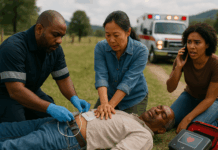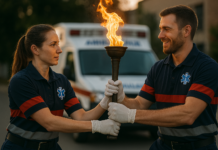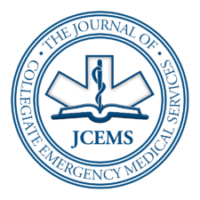Poster Presentation Abstract
Introduction: Stop the Bleed is a national initiative to increase bystander awareness on how to control a life-threatening hemorrhage, a skill that is becoming more imperative with the increase in mass casualty incidents. Inspired by the Binghamton University presentation at the 2017 NCEMSF conference, Skidmore College Emergency Medical Services (SCEMS) brought Stop to Bleed to Skidmore College, an upstate New York liberal arts college of 2,500 students. Program Development & Implementation: In celebration of National Collegiate EMS Week in November 2017, our team organized 20 free bleeding control trainings on direct pressure, tourniquet usage and improvisation, and wound packing. To make bleeding control equipment more accessible, we petitioned for kits that include tourniquets, gauze, gloves, shears, and an instructional booklet. These kits will be placed next to AEDs in academic buildings, dining halls, and student centers. A total of $5,000 was incorporated into the Skidmore Campus Safety 2018 budget proposal through collaboration between SCEMS leadership and Skidmore administrators. A Community Education Division within SCEMS was established to continue Stop the Bleed trainings. Program Evaluation: During National Collegiate EMS Week, over 60 members of our Skidmore community, which includes Skidmore students, professors, faculty, and local high school students, became bleeding control certified as per guidelines established by the American College of Surgeons. An additional 10 faculty members were certified after we led a requested training at our on-campus child care center. Discussion/Conclusion: Future division goals for the program include designing courses specifically for Skidmore professors and faculty members, certifying all of the Skidmore College sports teams, and holding trainings at local high schools in the Saratoga county region.
Author & Article Information
Author Affiliations: Emergency Medical Services, Skidmore College, Saratoga Springs, NY, USA
Address for Correspondence: Katie Pelham, EMT-B. E-mail: kpelham@skidmore.edu
Conflicts of Interest/Funding Sources: By the JCEMS Submission Declaration Form, all authors are required to disclose all potential conflicts of interest and funding sources. The authors declared that they have no conflicts of interest. The authors declared that they received funding from Skidmore College and private anonymous donors for the program and/or research described in this abstract.
Ethical Compliance: The authors attest that the research associated with this abstract was conducted in accordance with the JCEMS Ethics Guidelines.
Submission History: Received February 4, 2018; accepted for presentation and publication February 22, 2018.
Poster Presentation: This abstract was presented as a poster at the Academic Poster Session of the 25th Annual Conference of the National Collegiate Emergency Medical Services Foundation; February 24, 2018; Philadelphia, PA, USA. The poster is available for download on the JCEMS website.
Published Online: May 15, 2018
Published in Print: August 13, 2018 (Volume 1: Supplemental 1)
Reviewer Information: In accordance with JCEMS editorial policy, poster presentation abstracts undergo double-blind peer-review by at least two reviewers (JCEMS Editorial Board members and/or independent reviewers) prior to acceptance for presentation and publication. JCEMS thanks the anonymous reviewers who contributed to the review of this work.
Copyright: © 2018 Pelham, Mierzejewski, O’Connor, Ackermans, Madloch, & Epstein. This is an open access abstract distributed under the terms of the Creative Commons Attribution 4.0 International (CC BY 4.0) License, which permits unrestricted use, distribution, and reproduction in any medium, provided the original author and source are credited. The full license is available at: https://creativecommons.org/licenses/by/4.0/
Electronic Link: https://doi.org/10.30542/JCEMS.2018.01.S1.07








